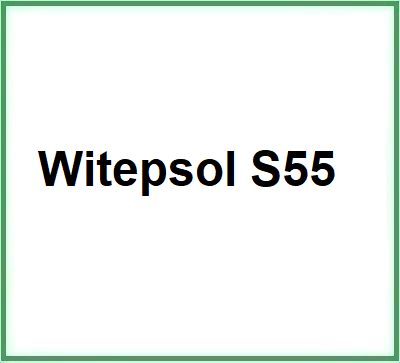Witepsol S55 is an inert hard fat used as base for drug release from suppositories progesterone.
The name describes the structure of the molecule:
- Witepsol is the trade name for a series of hard fats used as a base for suppositories. They are specifically blended to have certain melting properties and consistencies.
- S55 indicates a specific formulation or grade within the Witepsol range. Each grade has slightly different properties, such as different melting points, to meet the specific needs of suppository or other product formulations.
Description of the raw materials used in its production:
- Fatty Alcohols - Fatty alcohols are alcohols derived from natural fats and oils. They are typically obtained through the hydrolysis or reduction of triglycerides. The specific types of fatty alcohols used in Witepsol S55 may vary, but they are typically long-chain alcohols, such as cetyl alcohol or stearyl alcohol.
- Fatty Acids - Fatty acids are carboxylic acids derived from natural fats and oils. They are usually obtained through the hydrolysis or saponification of triglycerides. The fatty acids used in Witepsol S55 may include stearic acid, palmitic acid, or other saturated fatty acids.
- Saturated triglycerides. Usually derived from animal fats or vegetable oils, these are the main components of Witepsol S55.
- Antioxidants. May be added to enhance the stability of the product.
Industrial production of Witepsol S55 involves blending and processing the fatty alcohols and fatty acids to achieve the desired composition and properties of the final product. The exact details of the manufacturing process may vary depending on the manufacturer's proprietary methods and formulations.
Step-by-step industrial chemical synthesis process
- Purification of triglycerides: The triglycerides are purified from any impurities, such as free fatty acids or other substances.
- Mixing: The purified triglycerides are mixed in the correct proportions to achieve the desired consistency.
- Addition of additives: Antioxidants or other additives may be added to enhance the stability or properties of the product.
- Cooling and solidification: The mixture is cooled and solidified into suppository form.
- Quality control: A quality check is carried out to verify the physical and chemical properties of the product.
Witepsol S55 is primarily used as a base or matrix material in solid dosage forms, such as suppositories or controlled-release tablets. It provides stability, controlled release properties, and compatibility with various active pharmaceutical ingredients. The specific applications and formulations of Witepsol S55 may vary depending on the intended use and formulation requirements.
The quantities normally used are 1.1275 g for 125 mg suppositories, 1.15 g for 250 mg oral medicines (1).
Here are its main characteristics and applications
- Suppository Base - Witepsol S55 is primarily used as a suppository base in pharmaceutical preparation.
- Melting Characteristics - It has a specific melting range, making it suitable for suppositories that need to dissolve at body temperature.
- Compatibility - Demonstrates good compatibility with a wide range of pharmaceutical active ingredients.
The only problem with this grease is its oxidation when left in contact with air for a long time. It is therefore necessary to use the drugs that contain it in a short time.
Studies
Aminolevulinic acid-loaded Witepsol microparticles manufactured using a spray congealing procedure: implications for topical photodynamic therapy. Al-Kassas R, Donnelly RF, McCarron PA. J Pharm Pharmacol. 2009 Sep;61(9):1125-35. doi: 10.1211/jpp/61.09.0001.
Preparation and in vitro-in vivo evaluation of Witepsol H35 based self-nanoemulsifying drug delivery systems (SNEDDS) of coenzyme Q(10).
Nepal PR, Han HK, Choi HK.
Eur J Pharm Sci. 2010 Feb 19;39(4):224-32. doi: 10.1016/j.ejps.2009.12.004.
Release property of progesterone from a mixed-base suppository consisting of Witepsol W35 and Witepsol E85. Iwata M, Komiya S, Nakamura K, Kiuchi M, Andoh N, Hirahara F, Maitani Y, Takayama K. Drug Dev Ind Pharm. 2001 Nov;27(10):1039-45.
Optimization of the production of solid Witepsol nanoparticles loaded with rosmarinic acid. Campos DA, Madureira AR, Gomes AM, Sarmento B, Pintado MM. Colloids Surf B Biointerfaces. 2014 Mar 1;115:109-17. doi: 10.1016/j.colsurfb.2013.10.035
Effect of different bile salts on the relative hypoglycemia of witepsol W35 suppositories containing insulin in diabetic Beagle dogs. Hosny EA, Al-Shora HI, Elmazar MM. Drug Dev Ind Pharm. 2001 Sep;27(8):837-45.
Investigation of diazepam lipospheres based on Witepsol and lecithin intended for oral or rectal delivery. Sznitowska M, Janicki S, Gajewska M, Kulik M. Acta Pol Pharm. 2000 Jan-Feb;57(1):61-4.
References_____________________________________________________
(1) Ba B, Gaudin K, Désiré A, Phoeung T, Langlois MH, Behl CR, Unowsky J, Patel IH, Malick AW, Gomes M, White N, Kauss T. Ceftriaxone Absorption Enhancement for Noninvasive Administration as an Alternative to Injectable Solutions. Antimicrob Agents Chemother. 2018 Nov 26;62(12). pii: e01170-18. doi: 10.1128/AAC.01170-18.
Abstract. Neonatal sepsis is a major cause of infant mortality in developing countries because of delayed injectable treatment, making it urgent to develop noninjectable formulations that can reduce treatment delays in resource-limited settings. Ceftriaxone, available only for injection, needs absorption enhancers to achieve adequate bioavailability via nonparenteral administration. This article presents all available data on the nonparenteral absorption of ceftriaxone in humans and animals, including unpublished work carried out by F. Hoffmann-La Roche (Roche) in the 1980s and new data from preclinical studies with rabbits, and discusses the importance of these data for the development of noninjectable formulations for noninvasive treatment. The combined results indicate that the rectal absorption of ceftriaxone is feasible and likely to lead to a bioavailable formulation that can reduce treatment delays in neonatal sepsis. A bile salt, chenodeoxycholate sodium salt (Na-CDC), used as an absorption enhancer at a 125-mg dose, together with a 500-mg dose of ceftriaxone provided 24% rectal absorption of ceftriaxone and a maximal plasma concentration of 21 µg/ml with good tolerance in human subjects. The rabbit model developed can also be used to screen for the bioavailability of other formulations before assessment in humans. Copyright © 2018 American Society for Microbiology.
![]() Witepsol S55
Witepsol S55 

